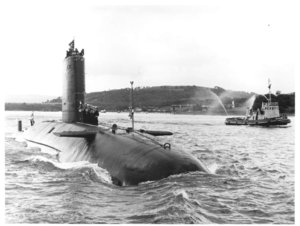HMS Conqueror (S48)
|
|
HMS Conqueror was a Churchill-class nuclear powered submarine that served in the Royal Navy from 1971 to 1990. She was built by Cammell Laird in Birkenhead. As of 2004, she was the only nuclear powered submarine to have engaged an enemy ship with torpedoes, sinking the cruiser General Belgrano.
Conqueror was the third of the class, the other two being Churchill and Courageous.
The main aim of these submarines was to face the Soviet threat at sea by attacking other ships and submarines, and spying on Soviet nuclear armed submarine movements.
However, Conqueror was most famously deployed during the Falklands War, setting sail from Faslane Naval Base on the River Clyde in Scotland on 3 April 1982, two days after the Argentine invasion. Conqueror arrived in the exclusion zone around the Falklands 21 days later. She was ordered to scan the area for Argentine shipping, particularly the Argentine aircraft carrier, Veinticinco de Mayo. However, on 30 April, she spotted the Argentine light cruiser, General Belgrano. Belgrano was sailing South West of the Falklands just outside the exclusion zone imposed by the British on Argentine shipping. After the opening shots of the war had occurred, British admiral, Rear Admiral J. F. Woodward, ordered Conqueror to sink Belgrano. The message was intercepted by Northwood, the Royal Navy's fleet command centre back in the UK. The British government, after some debate, allowed the decision to proceed. The basis for the decision was that the Royal Navy feared a pincer style attack with Belgrano attacking from the South and the Vienticinco de Mayo from the North. Also Belgrano could have escaped from Conqueror by sailing across shallow waters and attack the British Task Force.
The scene was now set, and on 2 May, Conqueror became the first nuclear powered submarine to fire in anger when she launched three torpedoes at Belgrano, two of which struck the ship and exploded. Twenty minutes later, the ship was sinking rapidly and was abandoned by the crew. The two escorting destroyers fled the scene under fear of further attack. 323 men were killed.
Conqueror's war did not end there. The crew of the submarine had to face Argentine air force attempts to locate the ship in the days after the attack, which had shocked the Argentine people, and the ruling dictatorship. Conqueror did not fire again in anger during the war, but the crew did provide valuable help to the task force by using their sophisticated monitoring equipment to track Argentine aircraft departing the mainland.
After the war, Conqueror returned to Faslane, flying the Jolly Roger, a customary act of Royal Navy submarines after a "kill".
Conqueror did not take part in any other official conflicts, and was decommisioned in 1990. The periscope of the submarine can be viewed in the Royal Navy's museum in Gosport.
Courageous is open to the public at Devonport Dockyard.
See HMS Conqueror for other ships of this name.
| Churchill-class submarine |
|
Churchill | Conqueror | Courageous |
| List of submarines of the Royal Navy List of submarine classes of the Royal Navy |


